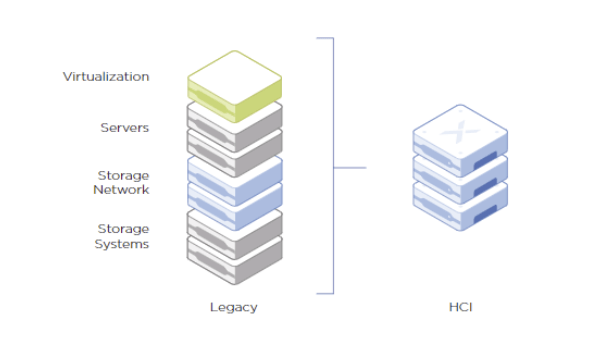Converged and Hyper-converged Secondary Storage: Definition, Uses, and Examples
If terms like “converged secondary storage” and “hyper-converged storage” make you feel like you’ve just stepped into an episode of Star Trek, you aren’t alone. Compared to traditional data center infrastructure models, these are relatively new concepts. However, more and more data center backup vendors are adopting these features into their product offerings.
As technology progresses, IT teams have less time and fewer resources while working on more projects. And, they’re experiencing higher than ever risks in terms of data protection. Designed to alleviate the complexity of safe data storage are Converged infrastructure (CI), which converged secondary storage is a version of, and hyper-converged infrastructure. They tackle this by combining processes that used to be separate such as backup, recovery, archiving, data management, and copy data management. This lessens the workload for IT teams by consolidating several pieces of hardware into one.
Read on to learn more about what these terms mean, starting with converged secondary storage.
What is converged secondary storage?
With advances in cloud backup capabilities, organizations have transferred their storage infrastructure from utilizing several hardware units to incorporating them into one. This is called converged secondary storage. As a form of CI, converged secondary storage incorporates storage, computing, and networking elements based on x86 hardware in a unified turnkey product. Converged storage vendors typically tout that this type of data storage is easier to purchase (one vendor vs multiple), faster to deploy and manage, and offers lower operating and capital costs.
It’s important to keep in mind that not all data center backup software provides converged infrastructure. These options may be suitable for organizations that are happy with their current storage setup and wish only to seek out third-party services specific to backup and recovery. However, leading vendors in the converged backup field, like Nutanix, include data encryption, data tiering, and backup to their converged infrastructure offerings, and even incorporate CI into their data management offerings outside of storage. Converged secondary storage and data center backup are not opposing parties, but rather two pieces of a broader data management puzzle.
A competitive converged infrastructure product for backup will have several qualities:
- Integrates everything from storage hardware and software (backup, deduplication, compression)
- A single, simplified user interface
- Backup capabilities
- Creates snapshots and clones
- Cloud-based, software-defined architecture
- Storage and backup scalability
- Non-disruptive syncs and upgrades
- Instant recovery
What is hyper-converged infrastructure?
Hyperconverged infrastructure (HCI) is very similar to CI, but differs in that it is software-defined versus hardware-defined. You may also see some vendors refer to it as “hyperconverged secondary storage.” HCI virtualizes data center backup. HCI vendors suggest that its main benefits are reduced costs, enhanced efficiency, and enhanced productivity within IT teams. The most common workloads running on HCI are smaller databases, but virtual desktop and SaaS tools work great with HCI as well.
One key difference between HCI and CI is in how you can (or cannot) divide data. With a converged infrastructure, computing, storing, and networking elements are discreet and can be divided. With HCI, components cannot be separated because of its virtualized nature.
For visual learners, or just those interested in a fantastic video on the topic, check out the great summary below
In this arena, Rubrik and Cohesity are two major players. Their HCI instruments both promise to break down silos that house distinct data protection and management tasks, including backup, archiving and restoration. In addition, they promise to provide low-cost, built-in infrastructure with hardware and software-defined architectures that are effective for scale-out, worldwide deduplication, and cost.
While adopting or extending CI and HCI can produce cost savings and improve efficiency, it is not a one-size-fits-all approach. With both solutions, it’s important to be mindful of keeping applications up and running, without interruption, given their support on the cloud and virtualization. It’s also important to be mindful of your particular project’s needs—for larger databases and online transactional processing, converged infrastructure may not be such a great fit.
With that said, below we will go into a little more detail about one of the best rated HCL options on TrustRadius.
Nutanix Cloud Infratsructure
Nutanix cloud infrastructure is one of the leading products in this space, and a strong choice for many use cases for those looking for Hyper-converged storage systems. This is a very complex type of storage solution, and everyone from managers to admins can find it intimidating. Nutanix is attempting to make their systems as simple as possible. They boast a streamlined management model targeted at business-critical; applications and databases.

The service includes:
- Enterprise-level data service capabilities
- Consolidated storage services
- Data Protection and Disaster Recovery
- Strong Integrated security features
- Virtualization
- Virtual Networking
- Management and Analytics tools
This is a well-reviewed product, something that is worth its weight in gold in emerging spaces. Some of the notable quotes include:
Nutanix AOS has been the final missing puzzle piece to moving towards a more flexible, agile, HCI based datacenter eliminating the complex management that is common with traditional or converged infrastructure. The automation pieces, especially the playbooks save so much time in larger environments by automating common tasks like expanding disk, memory, or cpu allocation to VMs. The overall UI is so much better than VMware or Citrix and the performance and ease of upgrades is on another plane compared to vxrail / vxstack or hyperflex.
Verified User┃Administrator in Information Technology┃Consumer Electronics Company, 5001-10,000 employees
We’ve been using Nutanix AOS to consolidate our converged infrastructure (CI) to hyper-converged infrastructure (HCI) across our entire estate. This has meant quicker deployment, less rack space, and simpler management overall.
Verified User┃Technician in Information Technology┃Telecommunications Company, 1001-5000 employees
A final point to consider with converged secondary storage is the startup cost. While vendors claim long-term cost savings, initial expenses may actually be greater. Given this concern, organizations should consider whether they will spend less by using a traditional secondary storage solution if it still meets their particular needs.
More Resources
If you are looking to learn more about these tools, or simply want to read more reviews, check out our full list of Hyper-Converged Infrastructure Systems.
For those that have used any of the platforms discussed here, please leave a review to help other buyers make informed decisions.
Was this helpful?
